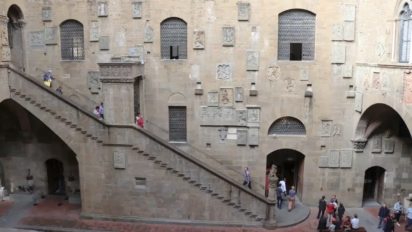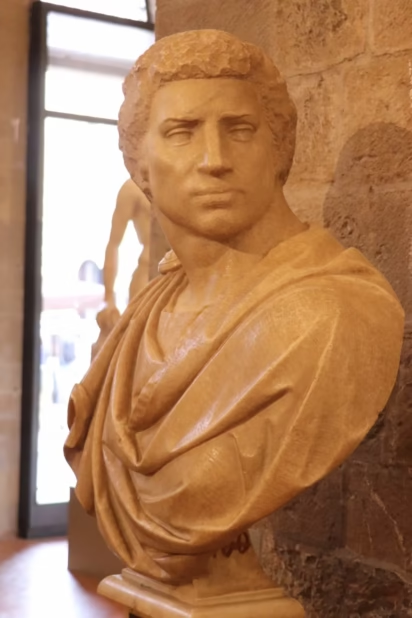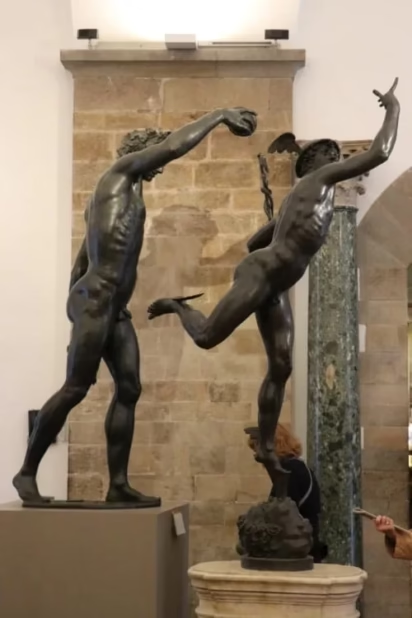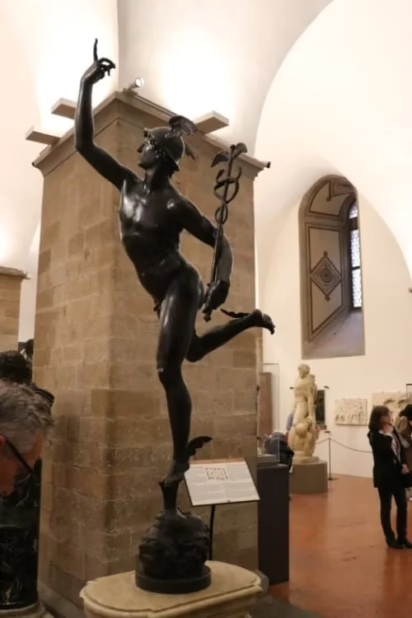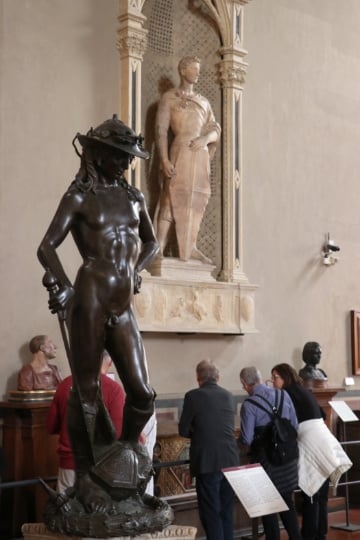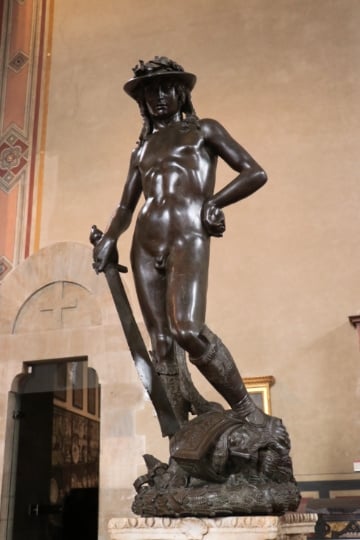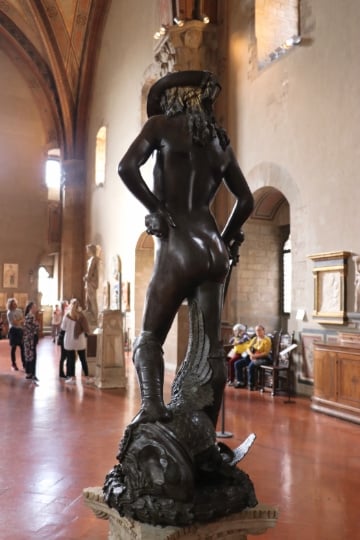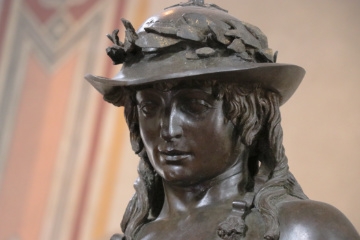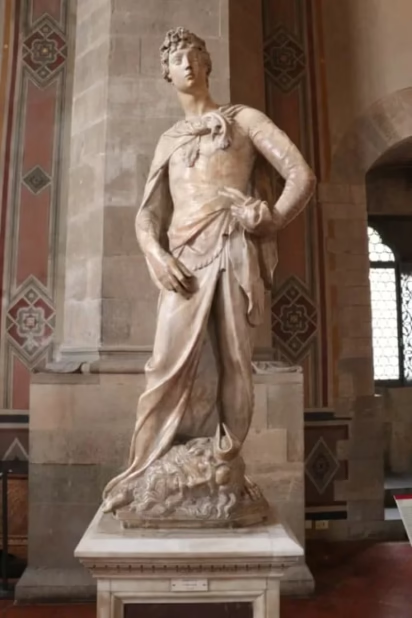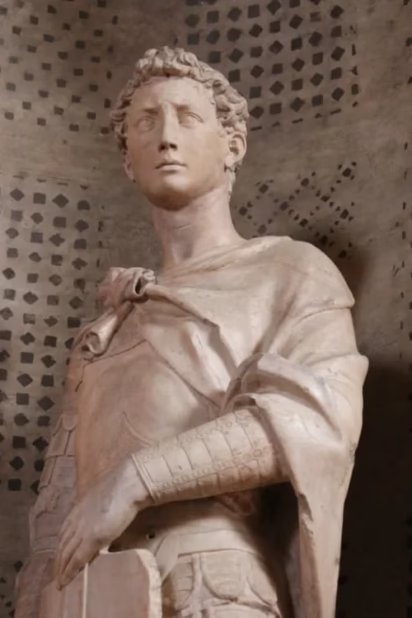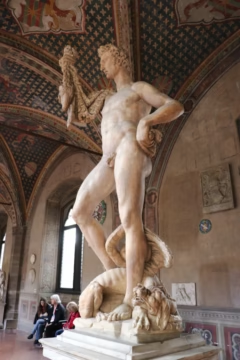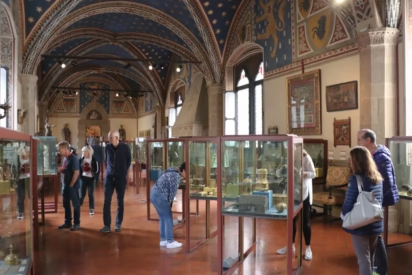The Bargello Museum near the Uffizi has the best collection of Renaissance sculptures in Florence including several by Michelangelo and two Davids by Donatello.

The Museo Nazionale del Bargello in Firenze focuses on medieval and Renaissance art. It is particularly famous for sculptures including some of the best works by Donatello (David, St George, Marzocco) and fine pieces by Renaissance artists including Michelangelo, Giambologna, and Cellini. Although these sculptures are the main reason for visiting, the museum also has interesting further collections including small bronzes, ivories, maiolica, jewelry, busts, and weaponry. A fresco of heaven in the chapel has the oldest known painting of Dante (possibly by Giotto). Time-slot reservation tickets are available (but not as essential as at the Uffizi) while guided tours are also an easy way to enter the museum at a specific time.
→ Top museums, churches, and sights in Florence are open mostly as normal in 2025 — see 2025: Florence Opening Hours of Top Sights, Museums, and Churches for the latest information and opening hours. The Firenzecard is again sold while the Turbopass Florence City Pass is a good alternative that includes online timeslot reservations for both the Uffizi and Accademia.
Visiting the Bargello Museum of Sculptures in Florence
The Bargello Museum is a relatively small museum near the Uffizi in the heart of Florence. Many visitors reduce the museum even more by only visiting the two main rooms with the Renaissance sculptures by amongst other Michelangelo and Donatello.
While tourists with limited time thus rush on to the other sights of Florence and Tuscany, less hurried visitors may enjoy further high-quality displays including small bronzes, maiolica, ivories, busts, weaponry, and decorative art.
At first glance, the Bargello appears like a small Palazzo Vecchio but the reality is the reverse. This smaller building is older and inspired the more famous palace. The oldest parts of the Bargello date from the 13th century. The building was mostly used by the city government including as police headquarters with prison and since 1865 as the first national museum in Italy.
The exhibition halls and galleries are spread around a large open courtyard. The Michelangelo room is on the ground floor behind the external staircase and the Donatello room is directly above it.
Michelangelo Room in the Bargello

The ground floor room of sculptures by Michelangelo and contemporaries is directly next to the entrance to the Bargello Museum. It is a good place to start a visit to the museum (or to peak in for a second view on the way out).
Some standout Michelangelo statues here are:
- Bacchus — a playful sculpture of the youthful, clearly tipsy Bacchus with a small satyr.
- Pitti Tondo — a large round medallion of the Madonna and Child with Mary’s head clearly exceeding the normal physical limits set by such framing.
- Brutus — the only bust Michelangelo ever produced.
- David-Apollo — it is uncertain whether this unfinished statue is Apollo pulling an arrow from his quiver or David with Goliath’s head at his feet. (Michelangelo’s famous David is in the Accademia and of course without the head of the giant.)
Sculptures by Michelangelo’s Contemporaries in the Bargello in Florence
Other sculptures in this hall are by contemporaries of Michelangelo and include amongst others:
The oft-copied large bronze Flying Mercury by Giambologna showing a naked Mercury balancing on the breath of Zephyr. At least two smaller copies are elsewhere in the museum.
Oversized sculptures by Baccio Bandinelli of Adam and Eve in front of a large window giving passers-by in the street a free view of their backsides.
Works by Benvenuto Cellini include a wax (displayed in a glass case) of Perseus with the head of Medusa — the large bronze is in the loggia on the Piazza della Signoria. Cellini also repurposed an antique torso (probably originally a Bacchus) to become Ganymede snatching eaglets away from a full-size eagle at his feet. This is an ironic reversal of the usual legend of the eagle (or Zeus) snatching Ganymede away to become a drinks bearer for the gods.
Bacchus, the Roman god of wine, was a very popular subject for Renaissance statues and the Bargello has many on display throughout the museum. In this room, in addition to the famous one by Michelangelo, are a further marble Bacchus by Jacopo Tatti (Il Sansovino) and a bronze by Giambologna, the first major large bronze by this Flemish artist. Two further marble Bacchus sculptures are in the gallery on the higher floor.

Donatello Room in the Bargello Museum
The Donatello Room, on the second floor directly next to the external staircase, has some of the most famous works by Donatello (1386-1466). This largest room in the palace is remarkably uncluttered but displays the best works of Donatello.
Donatello’s David Sculptures
Donatello’s most famous work, the relatively small bronze David (ca. 1440), naked but for a hat and some interesting boots, was revolutionary and hugely influential. It is considered the first full-round male nude statue produced in nearly a thousand years.
Rather than displaying the sculpture in a corner or niche, as was common in the Middle Ages, this David was made to be admired from all angles. It was the first time in the Renaissance that a subject was portrayed nude like a hero from classical antiquity. (It inspired Michelangelo to carve his famous David in the nude too — now on display in the Accademia.)
Often overlooked is the head of Goliath. It shows some intricate detailing in amongst others the beard and helmet of the slain giant.
Donatello’s other David is an earlier marble made around 1408. This is considered his first notable work. David’s body and clothes are still clearly rooted in the Gothic but the face has a hint of the classical. Once again, this is David after the fight, so it includes the head of Goliath done in remarkable detail.
(It is hard to believe these two Davids are by the same artist — ditto Donatello’s Mary Magdalene sculpture in the Museo dell’ Opera del Duomo, which is stylistically remarkably modern and similar to the bronze male head displayed near the bronze David.)
More Donatello Sculptures in the Bargello Museum in Florence
On the back wall in a niche is another remarkable work by Donatello — a sculpture of St George (1416). A slight turning of the torso suggests movement and not only shows Donatello being influenced by ancient statuary but also a clever use of space to make the sculpture appear larger than the restricted niche allows. The main sculpture shows St George with a huge shield, as the work was commissioned by the local shield makers’ guild. The customary slaying of the dragon is done in the predella below (although the Italians prefer to refer to it as liberating the princess).
This is the first example of Donatello’s experiment with stiacciato relief: to create perspective by increasingly flattening the relief towards the horizontal line. (A copy of this work may be seen for free where this one was originally positioned: on the exterior wall of the Orsanmichele.)
A further major Donatello is near the center of the room — the Marzocco heraldic symbol of Florence. The lion with a shield bearing the coat of arms of Florence was originally made for the apartments of Pope Martin V in Santa Maria Novella.
The room has several further works by Donatello, or previously attributed to him. Other works are by his mostly 15th-century contemporaries including Desiderio da Settignano (St John the Baptist), Luca dell Robbia, Michelozzo, and Bertoldo.
Brunelleschi vs Ghiberti in the Bargello
Two hugely popular works are the panels portraying the sacrifice of Isaac. These were the entries of Filippo Brunelleschi and Lorenzo Ghiberti in a competition to produce doors for the Baptistery — the received a joined commission, which Brunelleschi rejected. Ghiberti received the commission for a further set of doors for the Baptistery without needing to win a further competition. Michelangelo considered the later doors to be suitable to be the Gates of Paradise. (All the original doors are now in the Duomo Museum).
Many visitors see only the Michelangelo and Donatello rooms (and a few further sculptures in the courtyard galleries). Given the quality of the works on display, these visitors already had value for money compared to for example what may be seen for more expensive in the Accademia. However, there is much more to the Bargello and visitors with a bit more time may enjoy a variety of further displays.
Sculptures in the Courtyard of the Bargello Museum in Florence
The halls and galleries of the Bargello are arranged around a large open courtyard. On the wall above the open monumental staircase with a gate halfway up are the shields of families that qualified to serve as judges in Florence.
Several sculptures and reliefs are in the open galleries. At the top of the staircase is a large Jason with the Fleece (with the slain dragon at his feet) and several further statues of Bacchus. Note the bronze animal figures, including a turkey, originally made for a Medici garden.
The ground floor gallery has numerous sculptures too including the coronation of Ferdinand II of Aragon, musicians from the coronation ceremony, Giambologna’s Oceanus, and the group fontana di sala grande.
Louis Carrand Collection in the Bargello Museum
Directly off the Donatello room on the upper floor is the display of Islamic art with a fine collection of textiles. Much of this gallery, as well as the eclectic treasure trove in the next hall, is from a 2,500-item donation in the 19th century by Louis Carrand, an antique dealer from Lyon.
It covers all genres, eras, and cultures around the world. Rather than trying to make sense of it all — the only real link is that everything was donated by Carrand — it may be better to just focus on a few to admire the intricate details and workmanship of otherwise briefly described items while walking through to the chapel.
Mary Magdalene Chapel in the Bargello
The Mary Magdalene Chapel is in the oldest part of the building and dates from around 1280. The 14th-century frescoes were plastered over when the building became a prison in 1574. Condemned prisoners spent their final night here before their execution in the courtyard.
Rumors that the frescos were by Giotto and contained the earliest known painting of Dante were mostly confirmed when they were uncovered in the mid-19th century. Now generally attributed to the workshop of Giotto, as the commission was very close to the time of his death, one of the individuals in heaven is considered to represent Dante — the figure in dark red standing directly behind the kneeling person on the right-hand side of the painting. Hell, largely damaged, is on the opposite wall with the three-faced satan from Dante’s Divine Comedy at its center.
Maiolica, Bronzes, and Weaponry in the Bargello
Further displays include a large collection of ivories and medieval art, mosaics, religious items, and paraphernalia. Many works show exquisite and intricate details worthy of closer inspection.
The museum is also famous for its fine collection of glazed terracottas and maiolica. These include household items, representation chargers, and vases but also a vast collection of decorative art from palaces and churches. The maiolica masterpieces by Andrea and Giovanni della Robbia are particularly praised. These colorful decorations are from the same period as Michelangelo’s works and probably more reflect the general taste of the era.
The Bargello also has one of the most important collections of small bronzes in the world with works dating from the Medici era up to the 18th century. Many of these sculptures are miniature versions of famous works seen elsewhere in Florence (and indeed in this very museum).
Further galleries include weaponry, knight armor, medals, and instruments of war.
Visitor Information for the Bargello Museum of Sculptures in Florence
Opening Hours of the Bargello Museum in Florence
The opening hours of the Bargello Museum are a bit tricky. It is closed on all Tuesdays and the second and fourth Sundays of the month.
From March to the end of 2025, opening hours are uncharacteristically simple: daily (except Tuesday) from 08:15 to 18:50 but closing at 13:50 on Sundays.
Admission is free on the first Sunday of each month.
Tickets for the Bargello are around €10, free for children up to 18, and €2 for EU nationals 18 to 25. Advance online tickets may be bought for specific time slots but at a surcharge. In contrast to the Uffizi and Accademia time-slot tickets are less essential except at peak season.
A combination ticket with all Bargello-managed museums in Florence is worth considering. This €21 Biglietto Cumulativo Musei del Bargello gives access to the Bargello, Cappelle Medicee, Davanzati, Orsanmichele, and Casa Martelli within 72 hours. Check the different closing dates to avoid missing out. (An annual pass is €50 and offers further discounts.)
The Firenze Card is valid. It works as a skip-the-line here so go directly to the entrance without picking up a ticket first. The Turbopass Florence City Pass is a good alternative that includes online timeslot reservations for both the Uffizi and Accademia.
The various items have short descriptions — mostly in Italian and English — but some may prefer a more comprehensive guidebook or audio tour. Guided tours are also available as part of a group or private, which for a small group or family may work out cheaper.
No food or drink is available inside the museum but there are endless cafes, restaurants, and gelaterias in the immediate vicinity.
More Articles on Florence Sights
The high season in Florence is increasingly long: Easter, May, July, August, and the Christmas holidays are especially busy. November and January to mid-March are the only quiet months, except for the February school holiday week. Plan and book time-slot reservation tickets and tours when available in advance — the Accademia and the Uffizi are again sold out weeks in advance. Top sights are quieter directly at opening time or in the late afternoon.
→→ Opening hours for top sights in 2025 — most sights have long hours but advance time-slot reservations are always sensible.
- Tips on Buying Tickets for the Uffizi Museum
- Tips on Buying Skip-the-Line Tickets for the Accademia (Michelangelo’s David)
- See Michelangelo’s David in the Galleria dell’ Accademia
- Visit the Duomo sights: Cathedral (Duomo), Baptistery (Battistero), Bell Tower (Campanile), Dome (Cupola), Museum (Museo), and Tickets + Opening Hours
- Visit the Bargello Museum of Sculpture (Donatello’s Davids)
- Visit San Marco Museum to see the frescoes and altarpieces painted by Fra Angelico.
- Visit Santa Maria Novella Church and Museum to see medieval and Renaissance Art.
- Visit Santa Croce for Giotto Frescoes and Michelangelo’s Grave
- San Lorenzo complex: Visit the Basilica for Renaissance Art, See the Laurentian Medici Library by Michelangelo, and Visit the Medici Chapels (Michelangelo Statues)
- Visit the Orsanmichele Church and Museum with sculptures.
- Save on Sightseeing in Florence with the Firenze Card (again available but not including transportation or the Duomo sights, or consider the Turbopass Florence City Pass that includes online timeslot reservations for both the Uffizi and Accademia.
- Travel to Pisa to see the Field of Miracles and the Leaning Tower of Pisa.
- Visit the magnificent Romanesque-Gothic cathedral in nearby Siena.
- Save on top Italian designer fashion at The Mall Factory Outlet Stores.
Florence Resources
- The official website of the Firenze Tourist Office is a bit cumbersome but has very useful information. Especially the pdf (alternative link) with the opening hours of all major sights. Unfortunately, it is only available for the current month but it is the second last line on opening hours — the final say is the guard at the door, NOT the ticket window!
- Get Your Guide offers tours of all major sights while Tiqets sells online tickets for many top sights in Florence.
- Book luggage storage online and explore Florence more easily on foot.
- Trainline is good for booking online train tickets in Italy and most of Europe.
